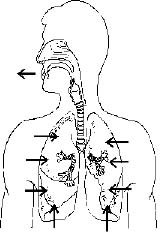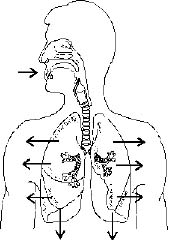
Oxygenation
November 17th, 2013
We breathe air into our lungs, where oxygen is transferred to the blood stream & transported to each cell in our body. At the cell wall, oxygen is absorbed & CO2 is released. The breathing cycle involves every muscle in the body directly or indirectly.
Our bodies function best in an environment where oxygen levels are at 32%, many areas of the planet have levels as low as 9%, which can be life threatening. Oxygen does not dissolve well in water, hence little oxygen is carried in the plasma. In 100 ml of oxygenated blood, only 3% of the oxygen is carried in the plasma. The other 97% is carried in chemical combination with haemoglobin.
Breathing problems are common.
One of the major reasons for this is poor breathing habits. Many people, especially when stressed or anxious actually breathe in the reverse order to the natural cycle. They breathe in & reduce lung capacity by constricting their chest & pulling in their abdomen. The shoulders will roll forward & the hips will roll backwards.
When breathing properly, as we inhale, our abdomen & chest expand, the diaphragm pushes down & out, the ribs rise up & out, the shoulders roll back & the hips roll forward. Our cranial bones open minutely & the spine straightens & massages the pituitary gland.
This is why poor posture affects breathing.


Breathing is the major activator of our lymphatic system. The action of the diaphragm pumps lymph around the body. The rhythmical contraction & extension of the movement of all our muscles moves the lymph through the body, delivering nutrients to the cells & carrying away toxins.
Restricted lymph flow leads to a build up of toxins. Reduced oxygen absorption can also increase levels of toxins.
If not enough oxygen is supplied to the cells they stop breathing & start fermenting available sugar. The cells can lose up to 30 levels of organization & start to function at the level of plant cells. Instead of functioning as a organ cell for example, they simply grow, forming a tumour which is basically a toxic waste dump.
Oxygen combines with toxins to soften & release them. Hydrogen hardens the body. Without oxygen the body will harden, becoming inflexible & toxic. Germs, parasites, viruses, fungi & pathogens are strictly anaerobic (Living in absence of free oxygen) at some stage of their life cycle.
Poor oxygen absorption may be involved in conditions related to toxaemia, eg.
- Candida
- Headaches
- Virus infections
- Cancer
- herpes
- MS
- AIDS
- Arthritis
- Hepatitis
- Cataracts and vision problems
- Poor learning & memory
- Co-ordination & behavioural problems
Changing a person?s breathing pattern can have a major impact on body, mind & spirit.
This information from Dr. Marc Sircus has just become available:
Oxygen Deficiencies
A lack of oxygen causes a critical decrease in the cardiac output[1]; meaning that less oxygen is transported through the body. For example, the oxygen supply of an 80-year-old person can go down by as much as 66% of the maximum amount. Human beings can take a lot of punishment mentally and physically, so these frequent drops in our ability to utilize oxygen efficiently rarely results in death. However, each series of oxygen deprivation takes its toll, and if a few cells stagnate or die here and there due to constant (external or internal) stress, it begins to add up. The result is premature aging due to the accumulation of these unresolved stress events.
Michael Grant White, ?The Optimal Breathing Coach? tells us that, ?The most punishing oxygen users for the body are major operations, heart weakness, poor posture, tension in neck and around shoulders, acute and repetitive trauma, too much exercise, chronic inflammation, poor digestion, poor diet, negative attitude, fungal, viral or bacterial infection, toxic stress, chronic sinusitis, food allergies, sleep apnea, snoring issues, shallow breathers, asthma, emphysema, heart attack, stroke, lack of exercise, dehydration, cancer, chemotherapy, acidic body pH, weak kidney?s, high stress levels (especially when accumulated over time).? In these situations the human body has a resilient capacity to maintain basic functionality (even through severe imbalances), but when the thresh hold of not being able to optimally recover is crossed the hands of time start counting.
A growing problem is that oxygen concentrations in and around major cities have been measured as much as 30% below normal. That means that each breath yields less oxygen. Working in lower oxygen environments is often detrimental to one?s health. Closed office buildings with no windows that open, breathing recycled indoor air, or working around machinery that uses up oxygen or produces carbon monoxide such as furnaces, gas stoves, automobiles and others all reduce the amount of viable oxygen in the air we breathe.
As if this were not bad enough most individuals have developed poor breathing habits, further restricting oxygen intake. These poor breathing habits are an easily recognizable modern day phenomenon according to breathing coaches and yoga teachers assessing individuals enduring stressful environments and exceedingly busy lifestyles. This resulting oxygen deficiency has a negative effect on your health and your overall performance. Initially a slight decline in performance and health is noticed by many as their biological balance shifts for the worse.
Now common and growingly recognized by a concerned medical community are lung and bronchial problems. Not only do they contribute to oxygen deficiencies but when combined with mild nutritional anemia the red blood cells that carry oxygen to the tissues are either deficient in number, or are damaged in some way. While many do not realize it, mild anemia is quite common, especially among young adults, menstruating women, vegetarians, and those with ongoing illnesses. Magnesium deficiencies incidentally are almost universal in modern populations and are another major cause that decreases the oxygen carrying capacity of blood by negatively impacting hemoglobin levels.
If you are a smoker or are regularly exposed to second hand smoke additional damages to the lungs, often times severe, lead to decreased oxygenation of your tissues. Combined with impaired hydration, restricted circulation, and increased toxicity the effect of smoking or being exposed to second hand smoke are the well-established number one health risk.
The National Cancer Association estimates that quitting smoking by age 30 reduces the chance of dying prematurely from smoking related disease by more than 90%. Ironically, science and society as a whole have not begun to apply reverse logic to this well-studied and extensively researched causative factor. [2]
Oxygen deprivation is biologically associated with most types of chronic diseases, including cancer. Stress, fear, anxiety, and worry cause not only shallow breathing, but a habit of literally not breathing as much, or holding the breath. Not to mention a sedentary lifestyle is the worst thing for breathing. Those with the worst breathing habits are often people who do not do any exercise. Exercise and movement are the events that route oxygen to the body?s cells. So take a deep breath and go for a walk often. The association of poor breathing and a sedentary life style are two of the earliest telltale signs that disease in on the horizon.
[1] the amount of blood pumped out by the heart?s ventricles in a given period of time; ?a resting adult has a cardiac output of about three quarts a minute?